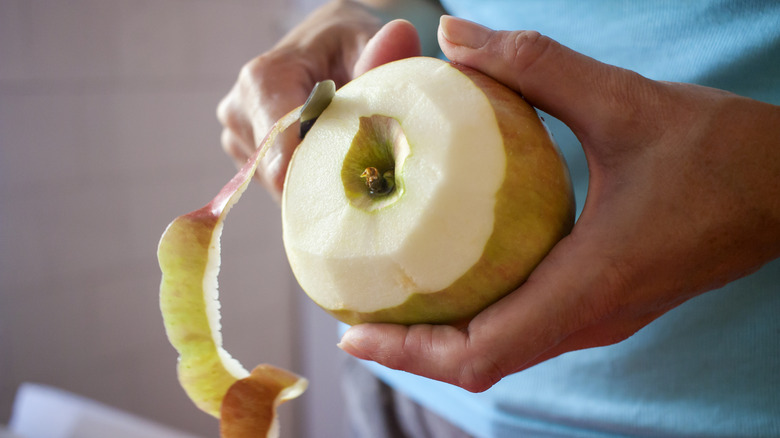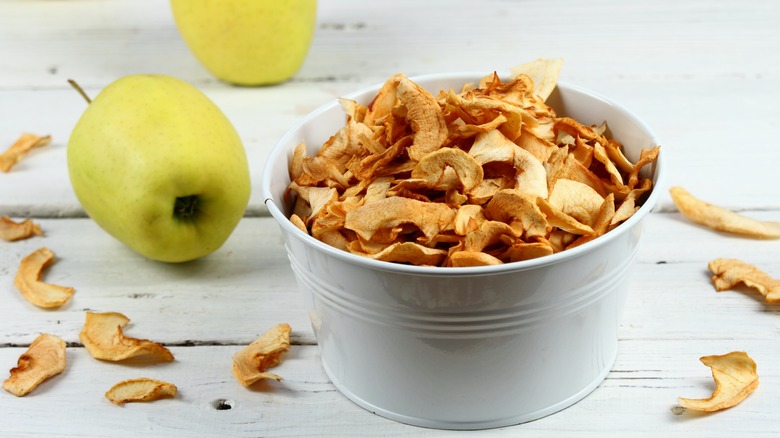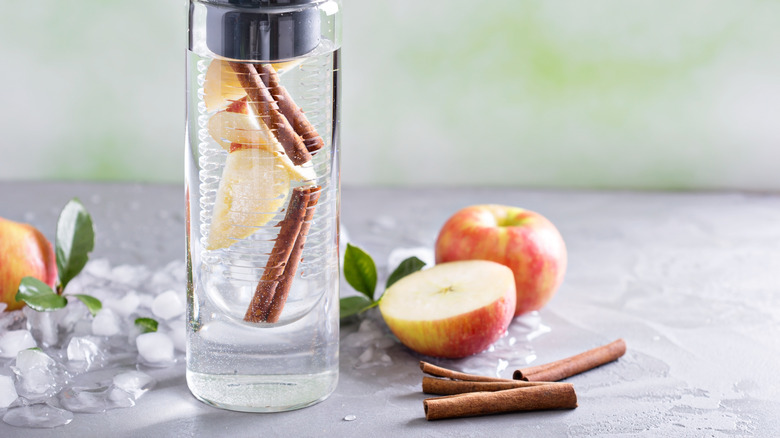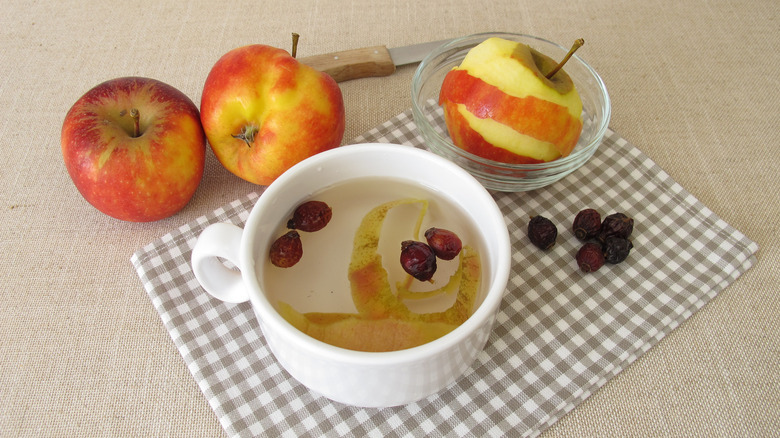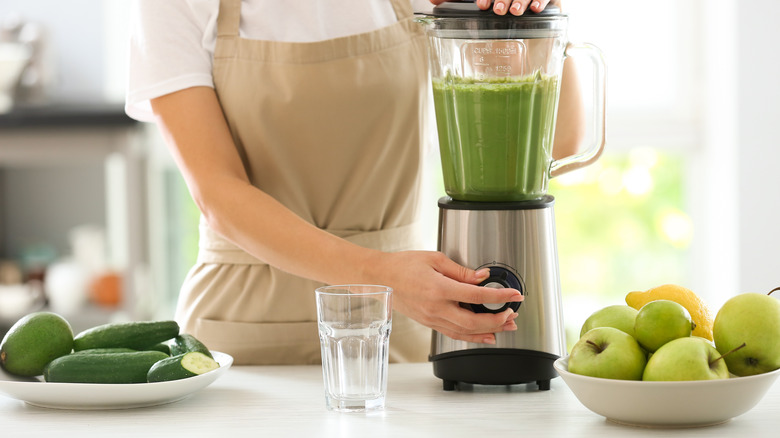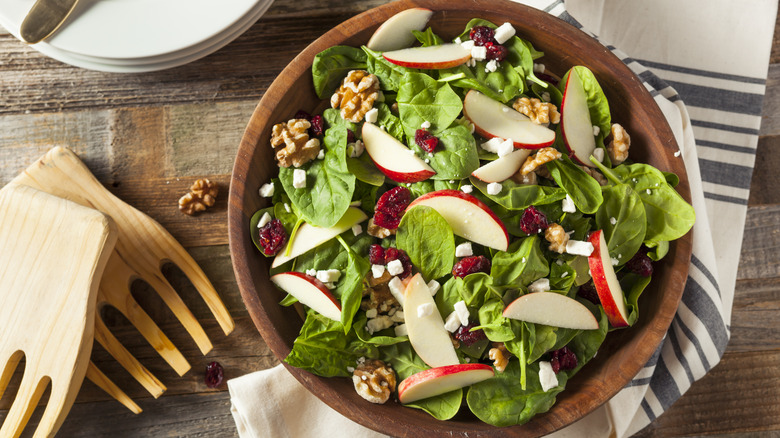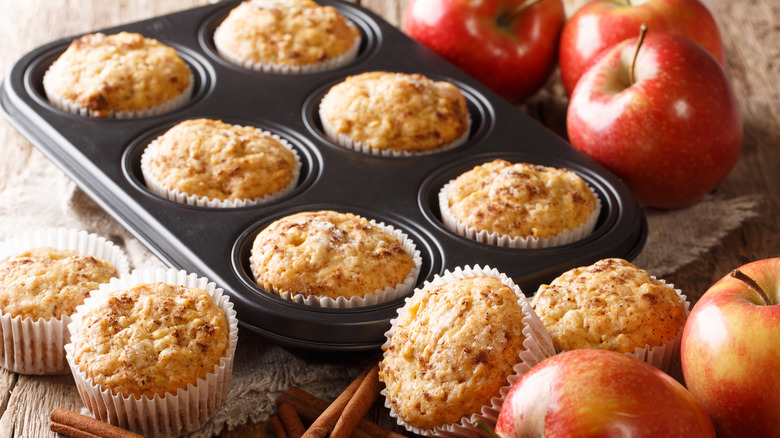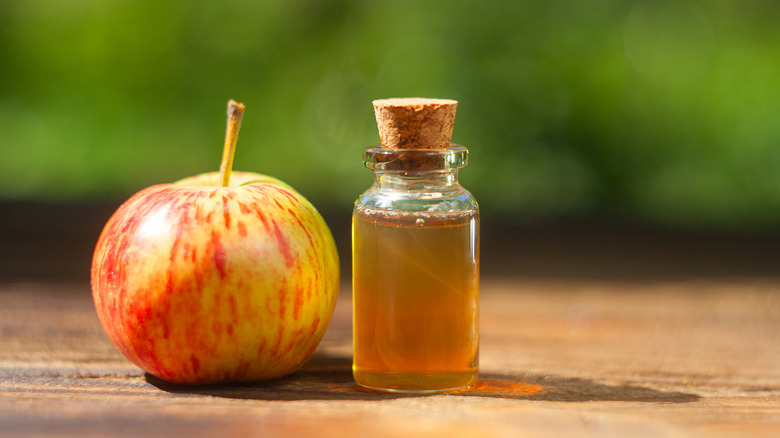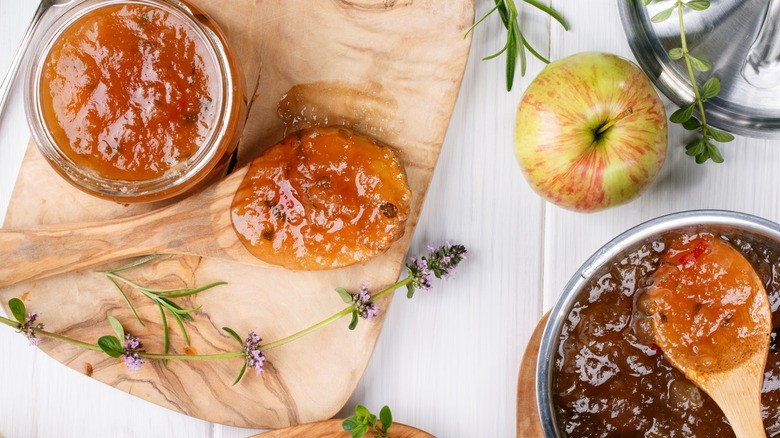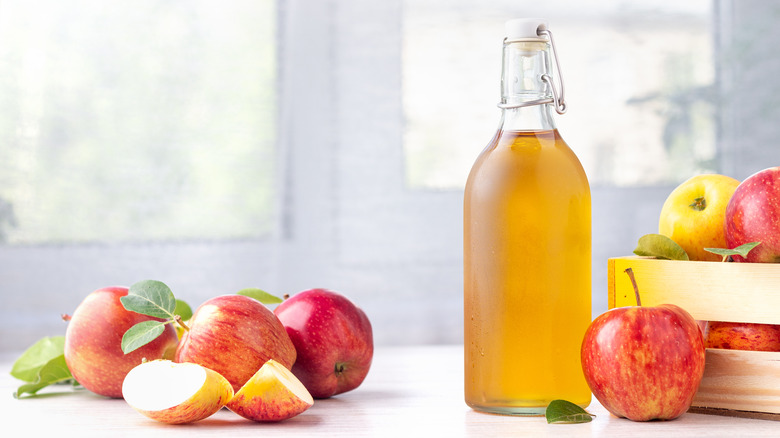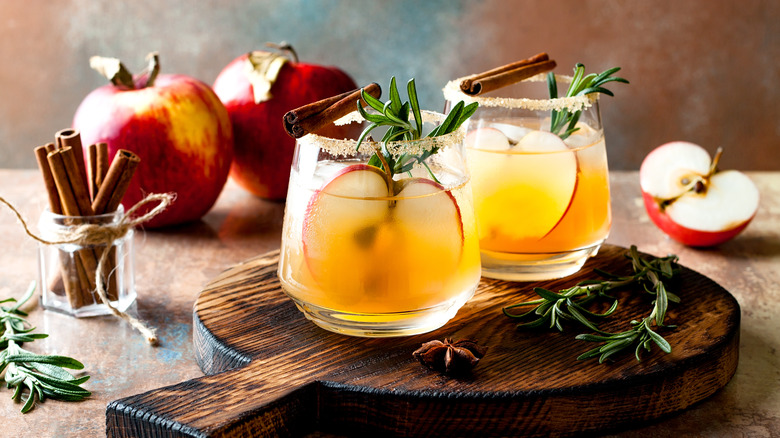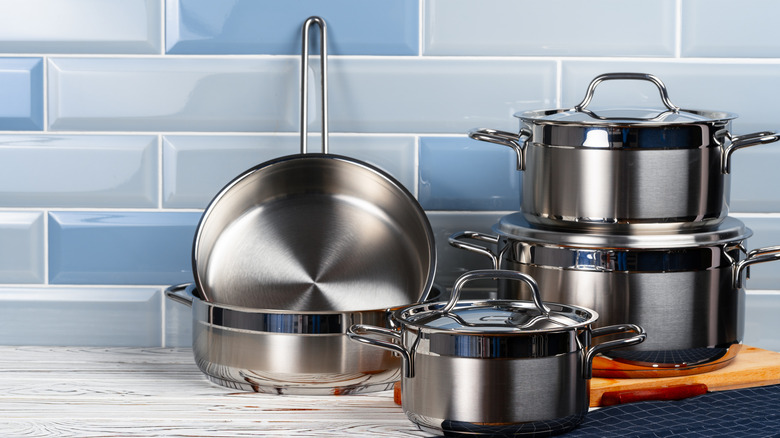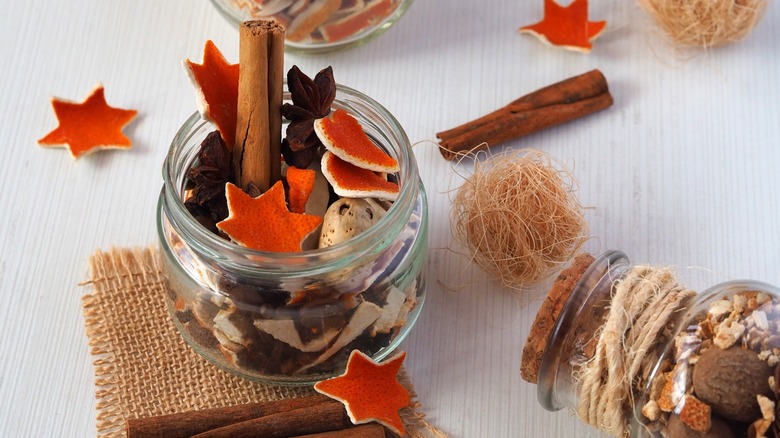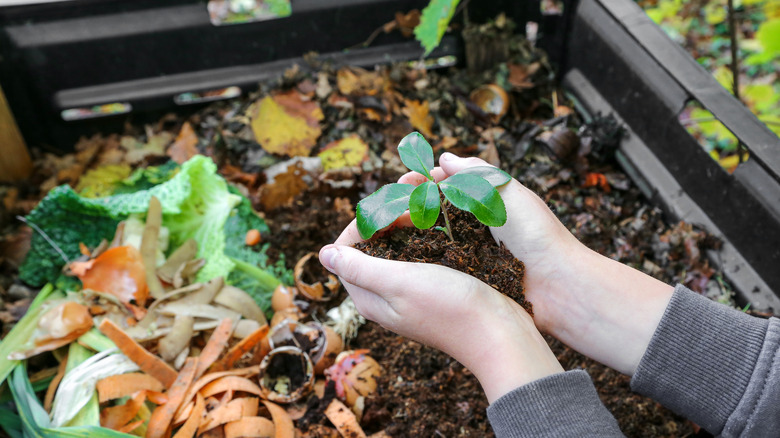15 Ways To Use Up Apple Peelings
Apples are delicious, versatile fruits that can be enjoyed fresh or cooked, sweet or savory, on their own or as a tasty addition to anything from oatmeal to salads to baked goods. After making a batch of applesauce, preparing a flaky pie, or peeling apple slices to appease a picky eater, you have probably found yourself with a pile of apple skins on the brink of being tossed in the garbage. In addition to making the most of your produce, reducing food waste by utilizing every part of the apple contributes to positive outcomes for the environment and the food supply. The USDA estimates between 30% to 40% of the food supply goes to waste with 31% of food loss occurring at the retail and consumer levels. Valuable nutrients and resources used to produce, transport, prepare, and store wasted food are all lost in a landfill. To combat this problem, the United Nations suggests consumers get creative to reduce food waste at home while speaking up in their communities and local governments.
Although food waste is a big problem, small actions daily such as finding ways to reuse apple peels are easy opportunities to minimize your impact. Wash your apples before peeling them to eliminate any residual pesticides, then enjoy the peels as a nutritious snack, transformed into baked goods, and even as a natural cleaner. Save money and the planet while making the most of your produce with these ways to use up apple peelings.
Turn them into a crunchy snack
Eating apples provide a variety of nutrients such as vitamins, minerals, fiber, and antioxidants, (via Harvard School of Public Health). However, much of the fiber and beneficial flavonoids are found in apple skins. Finding ways to incorporate the entire apple into your meals, whether eating it whole or finding innovative ways to consume the peels, is the best way to reap the most benefit from the fruit.
Using an oven, air fryer, or dehydrator, you can transform apple peelings into a crunchy, nutrient-rich snack. Environmentally-minded snack producers like RIND are already doing this with dried fruit products, all with skins intact. Meal kit service HelloFresh also offers suggestions for reinventing fruit peels as chips, candy, seasoning, and tea. To make crunchy apple skin chips in the oven, preheat to 300 degrees Fahrenheit and place the apple peels on a lined baking sheet. Season with a dash of cinnamon or get creative with your favorite blend of spices. Bake the peels for about 30 minutes, tossing halfway through to get them nice and crisp. Enjoy these crunchy snacks on their own, or as a way to add texture to salads, sandwiches, and wraps.
Stay hydrated with fruit infused water
Soak up the benefits of fruit-infused water by adding apple peels to your reusable bottle. In addition to keeping you hydrated, Dr. Danielle Hairston-Green of Prairie View A&M University, explains that infusing water with fruit and herbs offers flavor. The nutrients from the fruit can also support healthy skin and digestive systems.
Enjoy the refreshing flavor of apple skins on their own, or enhance them with other fruits, herbs, and spices. For a fall-inspired flavor, add orange peel, ginger, and cinnamon sticks to your water along with the apple peels, or give your water a bright, refreshing boost with apple peels, cucumber, and lemon. Infused water is a fun, versatile way to get the most out of produce scraps such as apple peels and cores, citrus rinds, mango peels, strawberry tops, herb stems, and even celery leaves. Check the produce for mold, then add scraps to the bottom of a pitcher or water bottle, stir, and let sit for at least an hour or up to overnight in the fridge, giving the fruit and herbs time to release their flavors.
Make tea
Apples are the perfect compliment to chilly autumn evenings, especially paired with cinnamon and served hot in a cute mug. Apple peel tea is a quick way to warm up on a cool autumn day. Simmer apple peels and spices such as cinnamon and clove with water for about 10 minutes, add some lemon or orange zest and cook for an additional minute, then strain the peels and spices before serving the cozy drink with lemon slices and a drizzle of honey. You can also use dried apple skins as the base of a spiced tea mix that is ready to brew whenever you want it.
For those in search of a cool and refreshing apple beverage, try transforming leftover apple peels and cores into an herbaceous iced tea. Apples pair naturally well with robust herbs such as sage, rosemary, and thyme to create a unique flavor profile. To make apple peel and herb iced tea, boil herb leaves with one part maple syrup to one part water for herbed simple syrup. Combine your favorite loose-leaf tea, herb stems, apple peels and cores, and cold water in a pitcher. Stir and press down the scraps, making sure they are covered by water. Let the ingredients steep in the refrigerator overnight. Strain the scraps and serve the brewed tea over ice, sweetened with your homemade simple syrup.
Boost a smoothie
Packed with important nutrients, apple peels are a great way to boost your favorite smoothie. If using apples in your smoothie, save prep time by setting aside the peeler and using the whole fruit. If you're debating whether to peel or not to peel prior to blending, know that apple peels, even when blended, might leave bits and pieces in the mixture. If you don't enjoy the texture of the blended peels, consider making some homemade dried apple powder as a way to boost the flavor and nutrients in smoothies, oatmeal, and more.
With its many health benefits, it is no surprise that apple peel powder is a sought-after supplement that can be purchased in health stores to increase fiber and other nutrients in your food. According to research in the National Library of Medicine, dried apple peel powder has been associated with increased joint function and range of motion, among other benefits. With leftover apple peelings, you can make your own fiber-rich smoothie booster at home. Use an oven or dehydrator to dry the apple pieces, then pulse the dried peels in a blender until they form a powder. Condition the powder in a low-temperature oven for 15 minutes, then store in an airtight container.
Sweeten a salad
With their subtle sweetness, apples work equally well when paired with sweet or savory dishes and are a great way to liven up an average salad. The best salad ingredients enhance the dish with color, variety, and texture. Adding a hint of sweetness along with a unique mouthfeel, leftover apple peels make a tasty and versatile topping for salads. Try incorporating apple peelings in a hearty spinach salad topped with walnuts, sharp cheddar, and dried cranberries, which also pair well with the apples.
Chopped leftover apple skins could make an interesting change to a classic chicken salad as well, offering a fresh element to balance rich and savory ingredients. Thinly sliced apple peelings can also help stretch out coleslaw while adding a subtle touch of sweetness to the mix. Whether using red or green apple peels, the vibrant skins are a colorful and nutrient-dense addition to the vegetable blend.
Bulk up breakfast and baked goods
Savory or sweet, there are many creative ways to cook with apples. Incorporating leftover apple peels adds texture, flavor, and nutrients to a variety of breakfast options and tasty baked goods. They can be included whole for the most texture as well as chopped or blended into a finer mixture. Apple peel powder can also bring a sweet and nutritious boost to your breakfast and baked goods.
Bulk up your oatmeal, pancakes, waffles, or yogurt with a handful of apple skins or apple peel powder for an extra dose of fiber in your morning meal. For a savory breakfast delight, try including chopped apple peels in your homemade sausage recipe to add a touch of sweetness to the mix. You can also enhance bread, muffins, pies, cinnamon rolls, marshmallow treats, and other desserts with leftover apple peelings. They work especially well in recipes featuring warm spices like cinnamon, cloves, or star anise for a fragrant, fall treat.
Upgrade your baking with homemade apple extract
Level up your baking with even more apple-forward flavor by transforming leftover apple peelings into homemade apple extract. Pure extracts made from scratch are easy to prepare and taste better than synthetic versions. You can make extracts of any flavor using a few simple ingredients that are free of artificial flavors, colors, and heavy corn syrup.
To prepare your homemade extracts, you only need vodka and natural ingredients such as apple peels, citrus rinds, or vanilla beans. A water and vegetable glycerin mixture can be used as an alternative to alcohol, or you can swap the vodka for bourbon for a richer flavor. It only takes a few minutes to combine the ingredients, but the process of extracting the flavor can take five to six weeks. If you have access to the sous vide machine, you can speed up the process and intensify the flavor using this helpful device. Extracts made with vodka or bourbon will keep for a long time thanks to the high alcohol content. The bottles should be stored closed and away from light and heat in a cabinet or cupboard.
Make apple syrup
Leftover apple peelings are made even more delicious with some added sugar. We suggest saving apple peels to make rich, homemade apple syrup by reducing the peels with maple syrup or brown sugar and water. The result will be a little thinner than traditional maple syrup, but not as runny as plain simple syrup, and can be further enriched with cream, honey, or butter. You can even make spiced syrup by mixing in cinnamon and other warm spices or create interesting and complex syrup flavors by incorporating ingredients such as citrus peels, herbs, bourbon, or berries.
Use your homemade apple syrup to sweeten coffee, tea, and cocktails. Drizzle your fruity syrup over yogurt or oatmeal, mix it into homemade granola, or pour some over French toast, waffles, or pancakes for an elevated morning meal. You can even use your homemade syrup to make a sweet compound butter to spread over bread, bagels, and muffins.
Reduce them into jelly
Pectin-rich apple peels are perfect for making a batch of homemade apple jelly. Science Direct explains that pectin is a carbohydrate and natural gelling agent found in fruits, particularly citrus rinds and apple peels. Pectin is used to solidify jams, jellies, or preserves and has been included in juices and other beverages to improve the viscosity and mouthfeel. Plant-based pectin mimics the effects of gelatin, which is derived from animals and has a variety of culinary uses from making a glaze for fruit tarts to firming up gummy candies.
Because apples naturally contain higher amounts of pectin, making apple jelly requires only a few ingredients including apple peels and cores, water, sugar, and lemon juice. The pectin in the peels will thicken the mixture as it boils, creating a delicious jelly that can be stored in the refrigerator to enjoy right away or processed in a water bath canner for long-term storage. You can also use leftover apple peelings to extract pectin for use in other recipes. The best type of apples for making pectin are very firm, green apples because pectin levels decrease as the fruit ripens. Use your homemade apple pectin for a wide range of cooking, baking, and canning projects.
Turn them into apple cider vinegar
There are many myths and claims attached to apple cider vinegar, but regardless of the purported health benefits, the tangy substance has a number of versatile uses in and out of the kitchen. Apple cider vinegar is a fermented product that can be time-consuming to prepare but is well worth the effort for its myriad of uses from making salad dressing to cleaning your home. Although it can be a long, laborious process, all you need to make apple cider vinegar are apple peels and cores, a little bit of sugar, and water.
In addition to whipping up homemade salad dressings, we suggest using your homemade apple cider vinegar as an all-purpose solution for just about everything from killing weeds and deterring flies to washing produce and enhancing your beauty regimen. In the kitchen, you can employ apple cider vinegar to make a quick buttermilk substitute by mixing it with milk or include it in marinades to tenderize meat. The sour liquid can be used in pickle recipes as well as to make salsas, homemade mayonnaise, relishes, and more.
Infuse your booze
No longer a mere garnish, leftover apple peels can infuse your booze with a boost of apple flavor. To make a simple, apple-infused liquor, pack a sterilized jar with apple scraps such as peels and cores and fill the container with liquor and seal it with a lid. Store the container in a cool dark place for several weeks, shaking the jar every few days. Strain the apple remnants and enjoy straight or creative cocktails. Customize your infused liquors with herbs, spices, and other fruits for unique, signature additions to your liquor cabinet.
For a boozy use for apple peelings that takes less patience, try adding them to sangria along with citrus peels for a fragrant addition to the fruity beverage. Creative connoisseurs might try infusing their homemade alcoholic concoctions with leftover peels. We suggest those interested in making their own wine consider adding leftover apple skins to the mix or incorporating them into a cozy recipe for hard cider.
Treat your pets
Many pet parents love to please give furry friends special treats. After talking with your veterinarian about your individual pet's needs, you might use your kitchen scraps to create tasty homemade treats your pet will love. According to the American Kennel Club, apple peels are good for dogs and can help ease digestive issues and maintain a healthy weight thanks to the extra fiber. However, refrain from feeding dogs apple seeds or cores as they contain small amounts of cyanide and may be a choking hazard. The apple peels can be eaten raw in small amounts or baked into chips or dog-friendly cookies.
Apple peels are a great snack for other types of pets as well, such as chickens, goats, and pigs. Offer leftover apple skins in small pieces for chickens to peck to save the peels from going into the trash. Goats and pigs will likely also enjoy the sweet apple treat.
Remove stains from cookware
Leftover apple skins are versatile kitchen scraps with a range of uses beyond the culinary world with surprising applications throughout the home. Fruit and vegetable peelings have many benefits around the home, including as a natural stain remover. The acid in apple peels can help break down grease stains and restore the shine of aluminum cookware and utensils.
To harness the cleaning power of your apple scraps, boil the pieces of apple skin in water and let them simmer in the stained aluminum pot or pan for about half an hour. Let the cookware cool, then wash it with dish soap, rinse, and dry it as usual. After applying this process, the stains and discoloration should be gone and your cookware will be restored to its original glory. Thanks to the fragrant fruit, you can also enjoy a fresh, lovely apple scent in your kitchen and home.
Freshen up with potpourri
Along with warm spices, the cozy smell of apples is a signature scent of fall. Freshening up your space with leftover apple peels can be as simple as pouring boiling water over a handful of apple scraps in a bowl, allowing the scent to disperse throughout the room. You can also capture the autumnal aroma with a do-it-yourself potpourri featuring leftover apple peels.
Fill your home with fragrance using a stove-top version in which the ingredients are added to water and simmered until the aroma fills the room or break out the dehydrator to create a dried mix that can be utilized throughout the house, even doubling as a cozy decoration. There are a plethora of uses for potpourri at home, in the car, for bags and suitcases, or as gifts. Dried apple skins can be placed in a small cotton sachet and placed in drawers or linen closets for an easy way to freshen up fabrics.
Enrich compost
If you find yourself with too many leftover apple peels to use before they go bad, note that apple skins can be frozen for future use. If wildlife frequents your yard, you might put them out for the squirrels, chipmunks, or birds to enjoy. However, if you do not wish to save your peels, consider returning any remaining bits to the soil by using them to enrich your compost. Make sure the apples have been washed to remove any potentially harmful pesticides or chemicals and take off any non-biodegradable produce stickers from the apple skins.
There are multiple ways to create compost, even if you are living in an apartment or other small space. The USDA explains that composting benefits the earth by feeding the soil without the use of chemical fertilizers, keeping food waste out of landfills, and conserving water by creating healthy soils. Two popular styles of compost include backyard composting and worm composting, also known as vermicompost. Apple peels can be broken down using either method, enriching the soil with the many nutrients found in the scraps while preventing food waste.
